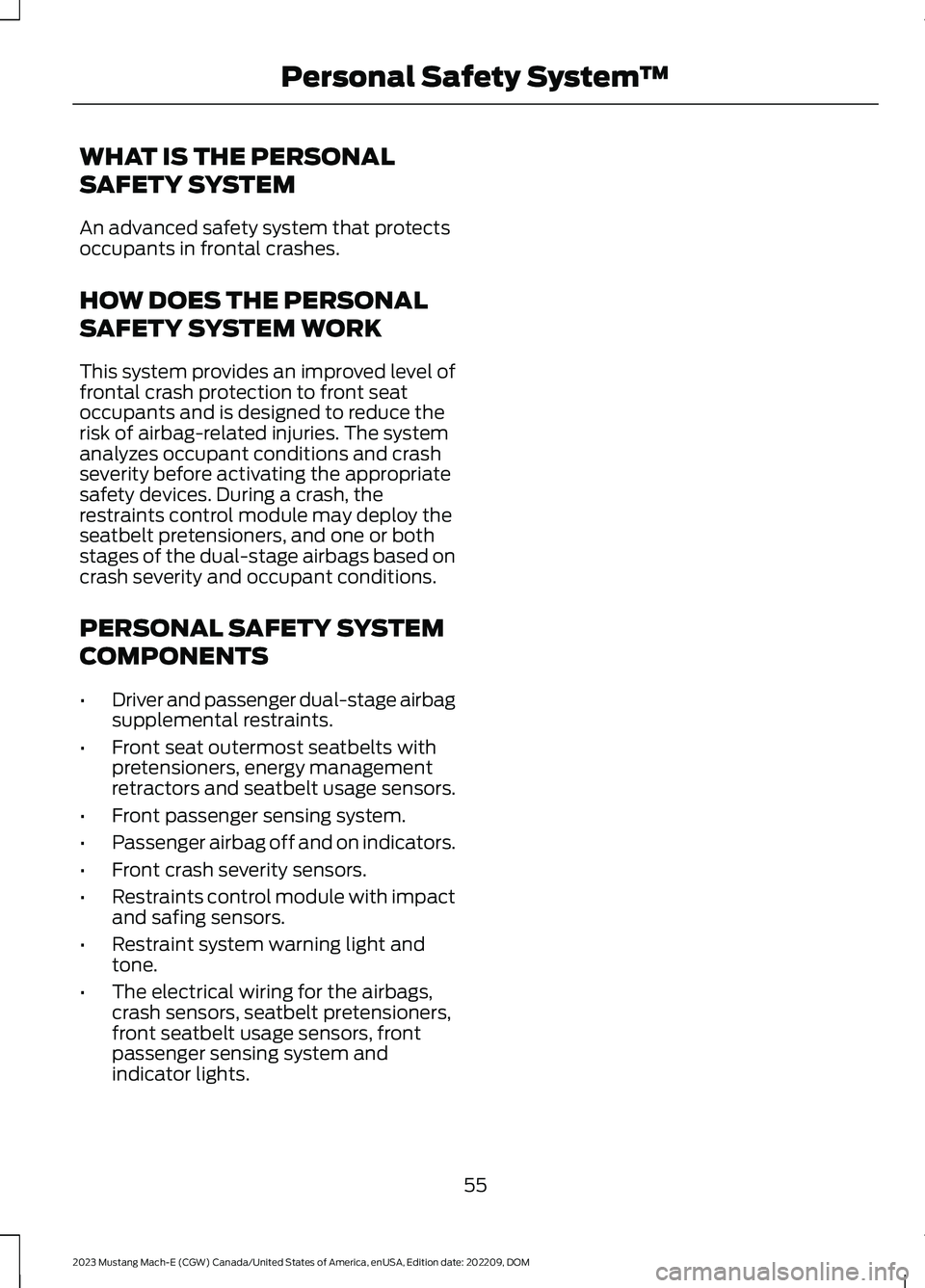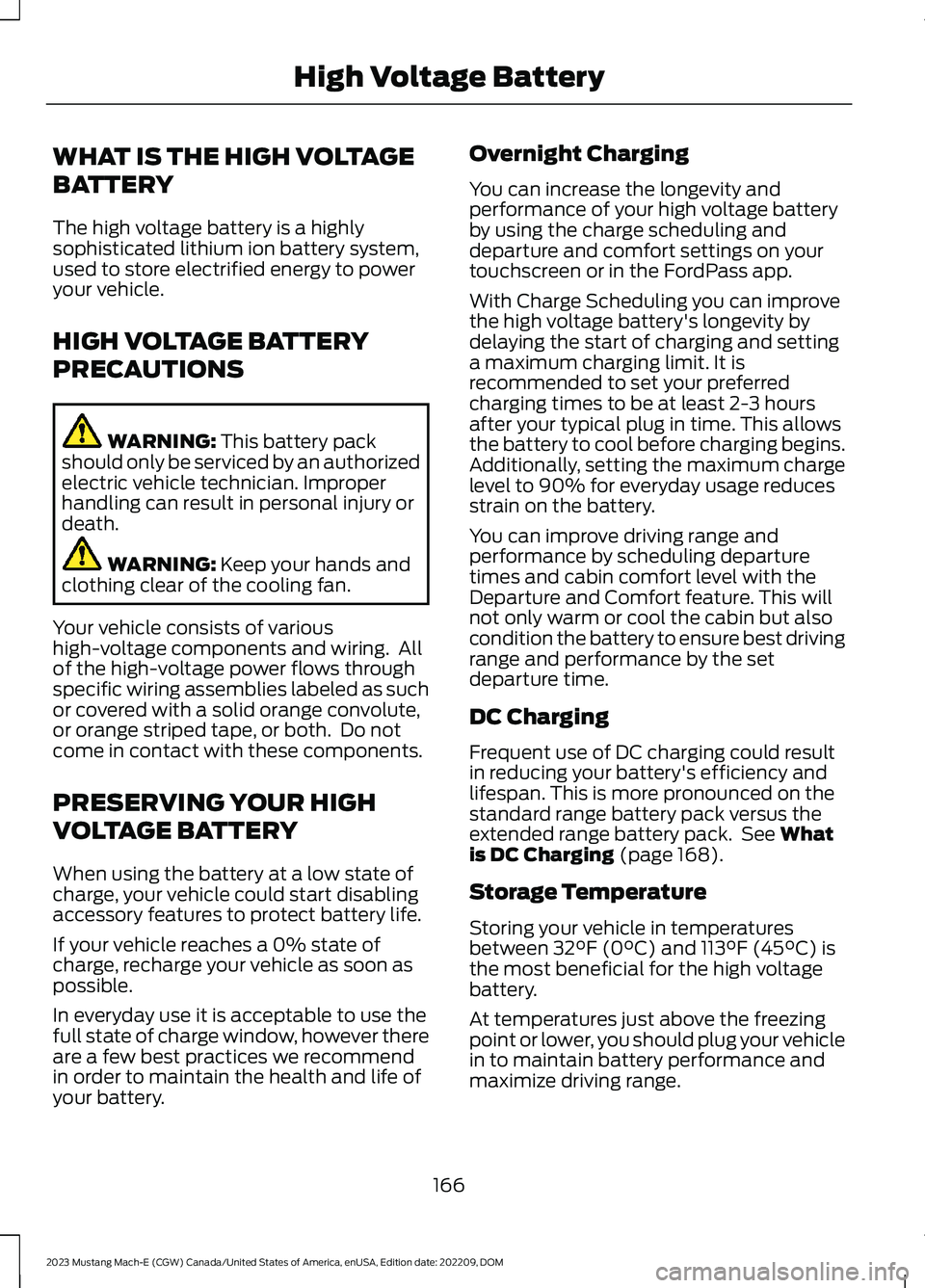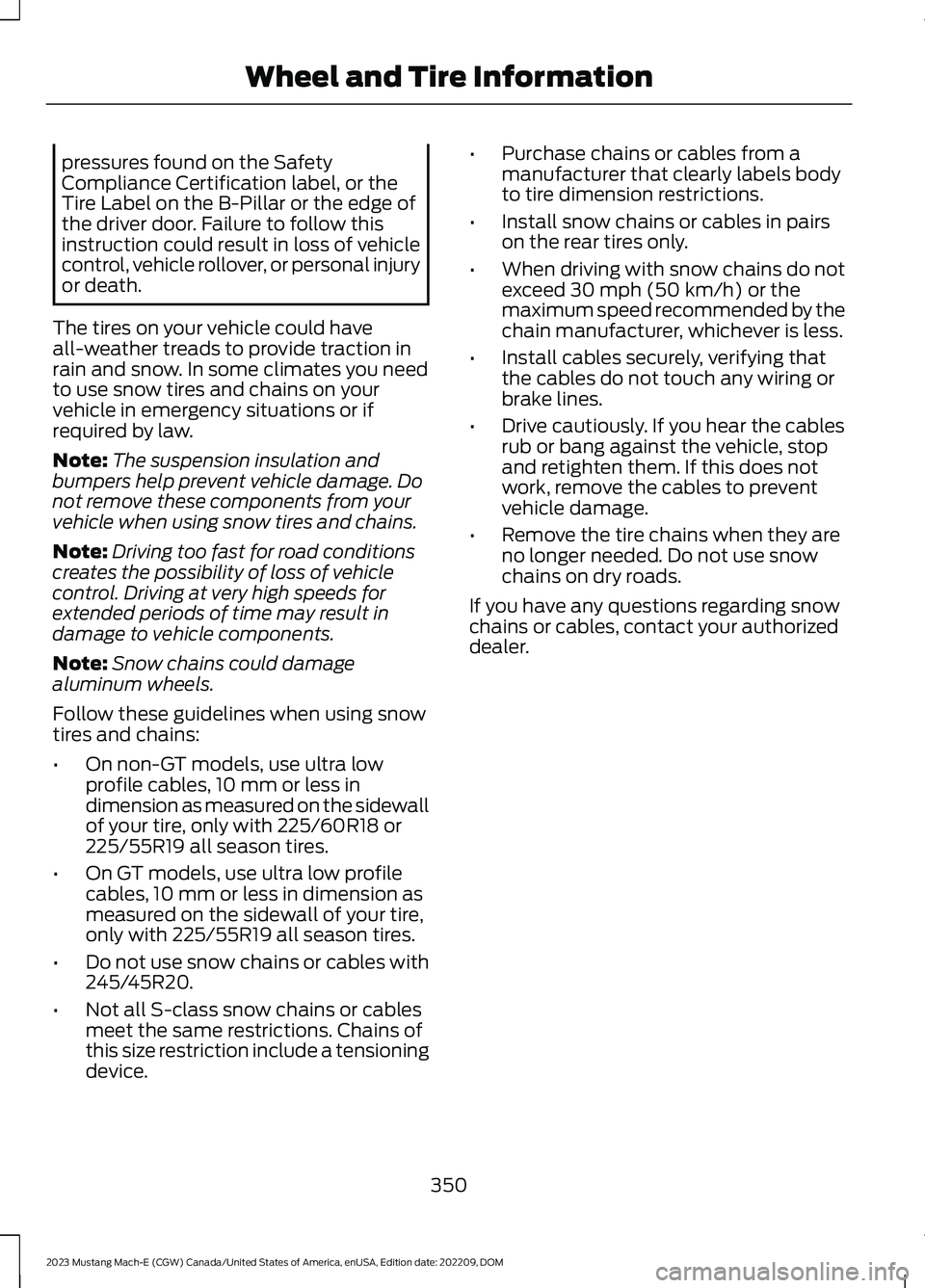wiring FORD MUSTANG MACH E 2023 Owners Manual
[x] Cancel search | Manufacturer: FORD, Model Year: 2023, Model line: MUSTANG MACH E, Model: FORD MUSTANG MACH E 2023Pages: 496, PDF Size: 13.09 MB
Page 59 of 496

WHAT IS THE PERSONAL
SAFETY SYSTEM
An advanced safety system that protectsoccupants in frontal crashes.
HOW DOES THE PERSONAL
SAFETY SYSTEM WORK
This system provides an improved level offrontal crash protection to front seatoccupants and is designed to reduce therisk of airbag-related injuries. The systemanalyzes occupant conditions and crashseverity before activating the appropriatesafety devices. During a crash, therestraints control module may deploy theseatbelt pretensioners, and one or bothstages of the dual-stage airbags based oncrash severity and occupant conditions.
PERSONAL SAFETY SYSTEM
COMPONENTS
•Driver and passenger dual-stage airbagsupplemental restraints.
•Front seat outermost seatbelts withpretensioners, energy managementretractors and seatbelt usage sensors.
•Front passenger sensing system.
•Passenger airbag off and on indicators.
•Front crash severity sensors.
•Restraints control module with impactand safing sensors.
•Restraint system warning light andtone.
•The electrical wiring for the airbags,crash sensors, seatbelt pretensioners,front seatbelt usage sensors, frontpassenger sensing system andindicator lights.
55
2023 Mustang Mach-E (CGW) Canada/United States of America, enUSA, Edition date: 202209, DOMPersonal Safety System™
Page 170 of 496

WHAT IS THE HIGH VOLTAGE
BATTERY
The high voltage battery is a highlysophisticated lithium ion battery system,used to store electrified energy to poweryour vehicle.
HIGH VOLTAGE BATTERY
PRECAUTIONS
WARNING: This battery packshould only be serviced by an authorizedelectric vehicle technician. Improperhandling can result in personal injury ordeath.
WARNING: Keep your hands andclothing clear of the cooling fan.
Your vehicle consists of varioushigh-voltage components and wiring. Allof the high-voltage power flows throughspecific wiring assemblies labeled as suchor covered with a solid orange convolute,or orange striped tape, or both. Do notcome in contact with these components.
PRESERVING YOUR HIGH
VOLTAGE BATTERY
When using the battery at a low state ofcharge, your vehicle could start disablingaccessory features to protect battery life.
If your vehicle reaches a 0% state ofcharge, recharge your vehicle as soon aspossible.
In everyday use it is acceptable to use thefull state of charge window, however thereare a few best practices we recommendin order to maintain the health and life ofyour battery.
Overnight Charging
You can increase the longevity andperformance of your high voltage batteryby using the charge scheduling anddeparture and comfort settings on yourtouchscreen or in the FordPass app.
With Charge Scheduling you can improvethe high voltage battery's longevity bydelaying the start of charging and settinga maximum charging limit. It isrecommended to set your preferredcharging times to be at least 2-3 hoursafter your typical plug in time. This allowsthe battery to cool before charging begins.Additionally, setting the maximum chargelevel to 90% for everyday usage reducesstrain on the battery.
You can improve driving range andperformance by scheduling departuretimes and cabin comfort level with theDeparture and Comfort feature. This willnot only warm or cool the cabin but alsocondition the battery to ensure best drivingrange and performance by the setdeparture time.
DC Charging
Frequent use of DC charging could resultin reducing your battery's efficiency andlifespan. This is more pronounced on thestandard range battery pack versus theextended range battery pack. See Whatis DC Charging (page 168).
Storage Temperature
Storing your vehicle in temperaturesbetween 32°F (0°C) and 113°F (45°C) isthe most beneficial for the high voltagebattery.
At temperatures just above the freezingpoint or lower, you should plug your vehiclein to maintain battery performance andmaximize driving range.
166
2023 Mustang Mach-E (CGW) Canada/United States of America, enUSA, Edition date: 202209, DOMHigh Voltage Battery
Page 354 of 496

pressures found on the SafetyCompliance Certification label, or theTire Label on the B-Pillar or the edge ofthe driver door. Failure to follow thisinstruction could result in loss of vehiclecontrol, vehicle rollover, or personal injuryor death.
The tires on your vehicle could haveall-weather treads to provide traction inrain and snow. In some climates you needto use snow tires and chains on yourvehicle in emergency situations or ifrequired by law.
Note:The suspension insulation andbumpers help prevent vehicle damage. Donot remove these components from yourvehicle when using snow tires and chains.
Note:Driving too fast for road conditionscreates the possibility of loss of vehiclecontrol. Driving at very high speeds forextended periods of time may result indamage to vehicle components.
Note:Snow chains could damagealuminum wheels.
Follow these guidelines when using snowtires and chains:
•On non-GT models, use ultra lowprofile cables, 10 mm or less indimension as measured on the sidewallof your tire, only with 225/60R18 or225/55R19 all season tires.
•On GT models, use ultra low profilecables, 10 mm or less in dimension asmeasured on the sidewall of your tire,only with 225/55R19 all season tires.
•Do not use snow chains or cables with245/45R20.
•Not all S-class snow chains or cablesmeet the same restrictions. Chains ofthis size restriction include a tensioningdevice.
•Purchase chains or cables from amanufacturer that clearly labels bodyto tire dimension restrictions.
•Install snow chains or cables in pairson the rear tires only.
•When driving with snow chains do notexceed 30 mph (50 km/h) or themaximum speed recommended by thechain manufacturer, whichever is less.
•Install cables securely, verifying thatthe cables do not touch any wiring orbrake lines.
•Drive cautiously. If you hear the cablesrub or bang against the vehicle, stopand retighten them. If this does notwork, remove the cables to preventvehicle damage.
•Remove the tire chains when they areno longer needed. Do not use snowchains on dry roads.
If you have any questions regarding snowchains or cables, contact your authorizeddealer.
350
2023 Mustang Mach-E (CGW) Canada/United States of America, enUSA, Edition date: 202209, DOMWheel and Tire Information
Page 474 of 496

ELECTROMAGNETIC
COMPATIBILITY
WARNING: Do not place objectsor mount equipment on or near theairbag cover, on the side of the front orrear seatbacks, or in areas that maycome into contact with a deployingairbag. Failure to follow theseinstructions may increase the risk ofpersonal injury in the event of a crash.
WARNING: Do not fasten antennacables to vehicle wiring, fuel pipes andbrake pipes.
WARNING: Keep antenna andpower cables at least 4 in (10 cm) fromany electronic modules and airbags.
Note:We test and certify your vehicle tomeet electromagnetic compatibilitylegislation. It is your responsibility to makesure that any equipment an authorizeddealer installs on your vehicle complies withapplicable local legislation and otherrequirements. Installation of someaftermarket electronic devices coulddegrade the performance of vehiclefunctions, which use radio frequency signalssuch as broadcast radio receiver, tirepressure monitoring system, push buttonstart,Bluetooth® connectivity or satellitenavigation.
Note:Any radio frequency transmitterequipment in your vehicle (such as cellulartelephones and amateur radio transmitters)must keep to the parameters in thefollowing illustrations and table. We do notprovide any other special provisions orconditions for installations or use.
Car
470
2023 Mustang Mach-E (CGW) Canada/United States of America, enUSA, Edition date: 202209, DOMAppendicesE239120